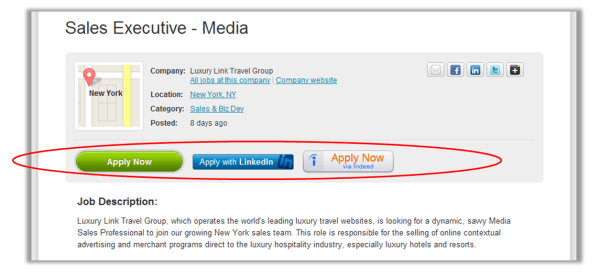 If you clicked through to read this post, you must have had a little niggling doubt in your mind that the answer to the title of this blog, in the case of your company, is ‘yes’.
If you clicked through to read this post, you must have had a little niggling doubt in your mind that the answer to the title of this blog, in the case of your company, is ‘yes’.
Maybe it’s because you thought your job ad was killer but you’re not getting the hoards of candidates you thought you be by now. Or maybe it’s because you’ve never received the amount of applications you thought you would have done for several jobs over the years.
Either way, you have your suspicions that your company’s application process isn’t all it’s cracked to be, and you want to know where you’re going wrong and how can you fix it.
Well, you’ve come to the right place.
First things, first…
 The first thing you need to know (if you did’t already) is that today’s job market is a candidate driven one and the quality of their application experience can and will influence their perception of the company they’re dealing with.
The first thing you need to know (if you did’t already) is that today’s job market is a candidate driven one and the quality of their application experience can and will influence their perception of the company they’re dealing with.
As a result, establishing a positive relationship with all potential candidates through a courteous, easy application process is essential to improving your reputation with job seekers and filling your talent pipeline with willing candidates for future hiring.
In order to establish such a relationship, companies must see the application process as a two-sided affair. We said before, that today’s job market is a candidate driven one and by that we mean that candidates are now just as capable of rejecting you, as you are of rejecting them.
So, if you entice them to apply with a fabulously creative job ad, but fail to persuade them to complete an application with a compelling application process, you may lose your talent to someone else. Simple as.
In the past, the application process has always favored recruiters and employers. We’ve always expected that if a candidate wants a job badly enough, they’ll take time out of their schedule to put together an application and fill out our forms regardless of how long that might take them. We’ve also always assumed that we need not contact everyone who has applied, just the people we believe are a good fit for the job in the end. Not any more!
The True Costs of A Bad Application Process
 Candidates are starting to develop negative opinions about companies with bad application processes. Nowadays, if the application process takes too long or a candidate doesn’t hear back from a company after spending a long period of time filling out an application form, candidates start to feel like it was a mistake to waste their time applying to that company in the first place, when they could have applied elsewhere.
Candidates are starting to develop negative opinions about companies with bad application processes. Nowadays, if the application process takes too long or a candidate doesn’t hear back from a company after spending a long period of time filling out an application form, candidates start to feel like it was a mistake to waste their time applying to that company in the first place, when they could have applied elsewhere.
Such bad feeling can lead to poor company ratings and bad publicity, none of which you want if you’re trying to attract top quality talent.
In fact, when surveyed by Careerbuilder, this is how candidates said they would respond to having a negative application experience:
- 42% said they would never seek employment at the company again
- 22% said they would actively tell others not to work for that company
- 9% said they would not purchase products and services from that company
In very stark contrast however, this is how candidates said they would respond to a positive application process (even if they were rejected):
- 56% said they would consider working for that company in the future
- 37% said they would actively tell others to seek employment in that company
- 23% said they would be more likely to buy that company’s products and services
Forming strong connections with interested candidates requires you to understand their side of the equation. For example, filling out lengthy application forms just might not be possible for someone who is already employed and therefore has considerable restraints placed on their time. So, you should be mindful of that fact when creating your application process.
Similarly, candidates hate being left in the dark when it comes to the application process. If they have spent the time filling out a form, perfecting it and sending it to you, they expect an acknowledgement of their effort for doing so. They need to know that you received that application and they need to know if they were successful with it, as a bare minimum.
How Can You Improve your Application Process?
 As the National Recruitment Partnership of Australia very eloquently put it:
As the National Recruitment Partnership of Australia very eloquently put it:
“The job application process is not a circus of spinning plates and flaming hoops for the candidate to balance and jump through, just to prove they want to work for your company. It should be a strategic and nuanced process respectful at every juncture that easily and skillfully determines which candidate shows the most appropriate skill set and best cultural fit.”
So how can you go about improving your company’s application process? Well, we’ve set out a few options we believe will bring any process up to scratch:
Providing Feedback
 First and foremost, as a bare minimum, your application process should recognise the people that go through it. Candidates do not look kindly on being left in the dark when it comes to the hiring process. In fact, it’s one of the top 3 frustrations they suffer when going through an application process.
First and foremost, as a bare minimum, your application process should recognise the people that go through it. Candidates do not look kindly on being left in the dark when it comes to the hiring process. In fact, it’s one of the top 3 frustrations they suffer when going through an application process.
Therefore, feedback is an essential element of not only a great application experience, but also a great candidate experience.
Honesty, transparency and clarity are what many recruiters feel candidate’s who are not hired, deserve to hear from the recruiter who has chosen not to proceed with them as a candidate.
And yes, if a candidate took the time to apply for your job in the first place, you should take the time to put together a proper response for why they didn’t get the job. Feedback builds better candidate’s for the future and will make the candidate respect your decision. As Stacy Zapar Donovan said:
“Today’s “no” candidate is tomorrow’s “yes” candidate (or source of referral) so never burn a bridge.”
One-Click Apply
Installing a one-click apply button on your careers site could be the best thing you ever do. One-click apply is a feature that allows candidates to apply for jobs quickly, using a stored resume and cover letter or in some instances an online profile, such as LinkedIn. Having the ability to apply for a job in one click means minimal effort on the candidate’s part and it could increase the number of applications you receive.
Take ZipRecruiter, for example. They split tested adding both LinkedIn and Indeed one-click apply buttons to their job ads in addition to their own one-click apply button and found significant statistical evidence to prove that adding the two buttons increased their overall volume of applications by 5%.

That was against a run rate of 200,000+ applications, so that 5% lift equated to an additional 10,000 applications per month. And to put that into perspective, ZipRecruiter made the point that if they were to try and buy enough traffic to generate 10,000 incremental applications, it would cost them between $20,000-30,000!
After their first full month of running both buttons, the breakdown of application method on ZipRecruiter looked like this:
FEBRUARY
- Indeed Apply: 6.9% (12,564)
- LinkedIn Apply: 6.4% (11,599)
- ZipRecruiter Apply: 86.7% (157,589)
Just one month later…it looked like this:
MARCH
- Indeed Apply: 10.1% (22,003)
- LinkedIn Apply: 6.6% (14,377)
- ZipRecruiter Apply: 83.3% (180,616)
The raw volume of applications through the Indeed Apply button shot up 75%! Then in June, the raw volume of applications through the Indeed Apply button went up again by another 66% over May.
JUNE
- Indeed Apply: 16.0% (38,610)
- LinkedIn Apply: 5.4% (13,017)
- ZipRecruiter Apply: 78.6% (188,747)
In just 4 months the Indeed Apply button utilization had increased by over 200% — from 12,000 applications to nearly 40,000 applications in a single month. What’s more, the bulk of these applications appeared to be incremental i.e. more candidates out of the same volume of traffic. You can’t argue with those figures!
Go Mobile
 60% of job seekers are now using their mobile devices to search for jobs and almost half of them are applying for the jobs they find via mobile search on those devices, as well. 40% of candidates will abandon a non-mobile application process.
60% of job seekers are now using their mobile devices to search for jobs and almost half of them are applying for the jobs they find via mobile search on those devices, as well. 40% of candidates will abandon a non-mobile application process.
But employers who accept mobile applications are twice as likely to receive as many quality applicants. So having a mobile optimised application process is a no-brainer.
As a general rule, applying by mobile should take no longer than 90 seconds. One-click apply buttons (as we’ve seen) are preferable, but if you require a candidate to enter some details when applying it is advisable to have no more than 7 mandatory fields.
Remember, candidates will be using their index finger to scroll through the site and click on any links, not their mouse. Therefore, buttons need to be big enough and text cannot be too lengthy.
Conclusion
The most important thing to remember when setting out or amending your application process, is that it is a two-sided process. And in order to establish a positive relationship with all potential candidates you need to have a courteous, easy application process in place. Companies that don’t risk leaving themselves open to poor company ratings and bad publicity at the hands of disgruntled former applicants.
The purpose of your application process is to encourage those skilled candidates who have sought out your job opening, to complete an application. It shouldn’t require them to jump through hoops in order to do so. Remember that.
See more at the Social Talent blog.
 About the Author: Siofra Pratt is a Digital Marketing Executive at Social Talent, which she originally joined as an intern in May 2013. In her current role, Siofra manages inbound marketing & content creation, social media management and advertising for Social Talent and is the voice of the Social Talent Blog.
About the Author: Siofra Pratt is a Digital Marketing Executive at Social Talent, which she originally joined as an intern in May 2013. In her current role, Siofra manages inbound marketing & content creation, social media management and advertising for Social Talent and is the voice of the Social Talent Blog.
A former banker, Siofra holds an honours degree in Commerce and an honours Masters in Creative Advertising.
Follow Siofra on Twitter @Sioffy or connect with her on LinkedIn.
Recruit Smarter
Weekly news and industry insights delivered straight to your inbox.





